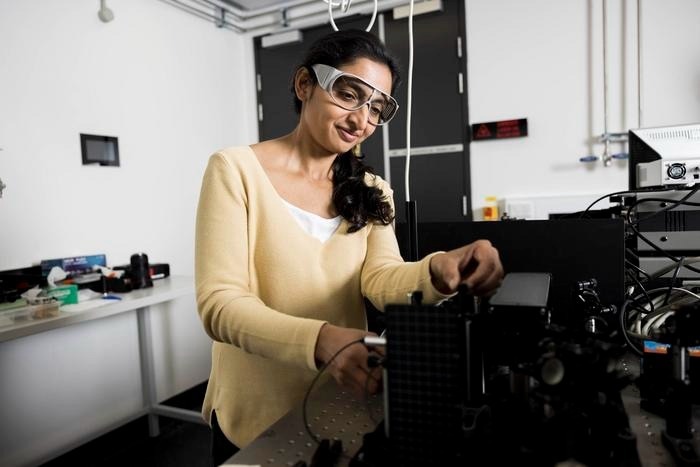Achieving photochemical upconversion in a solid state is a step closer to reality, thanks to a new technique that could unlock vital innovations in renewable energy, water purification and advanced healthcare.
 Dr Thilini Ishwara working in a laboratory at UNSW Sydney. Image Credit: Exciton Science
Dr Thilini Ishwara working in a laboratory at UNSW Sydney. Image Credit: Exciton Science
Exciton Science researchers based at UNSW Sydney have demonstrated that a key stage in the upconversion process can be achieved in the solid state, making it more likely that a functioning device can be manufactured at commercial scale. Possible applications include hydrogen catalysis and solar energy generation.
Their work has been published in the high-impact journal ACS Energy Letters and is likely to drive major changes in the approach of scientists around the world researching this challenging but potentially transformational field.
Professor Tim Schmidt of UNSW Sydney, an Exciton Science Chief Investigator and the senior author on the paper, said: “I think people are going to immediately start copying us. I consider this a breakthrough because this approach can be adapted to upconverting into the ultraviolet or from the infrared. There’s so much we can do with it.”
Upconversion involves gluing two low-energy photons of light together to create more energetic, visible light, which can be captured by solar cells or harnessed for other purposes.
The technical term for the gluing process is ‘triplet-triplet annihilation’, which produces a ‘singlet exciton’. An exciton is a quasiparticle which exists when an electron and the hole it is bound to becomes excited by light or another source of energy.
Controlled and reliable triplet-triplet annihilation and the photochemical upconversion it enables could raise the efficiency limit of solar energy devices from 33.7% to 40% or beyond.
Much of the fundamental research on upconversion is performed with liquid samples. For the mechanism to be useful in real-world devices applications, it must be effectively demonstrated in a solid state.
In this work, Exciton Science Research Fellow Dr Thilini Ishwara and her colleagues created a thin film of nanostructured alumina stained with a sensitizer.
The pores of the structure are filled with emitter molecules in concentrated solution, which allows a highly promising photon generation quantum yield of 9.4%.
The next step for the researchers is to move beyond the concentrated solution used in this approach and to achieve similar results in an entirely solid state, potentially by using a gel-like substance.
“If you can make it small enough, you could use it for even doing chemistry in the body,” Thilini said.
“You can generate higher energy light at a targeted place inside the body to treat tumors or create medicines with laser precision.
“Water purification is another use for upconversion. If you can upconvert the visible spectrum into quite a harsh UV, you can kill bugs and save millions of lives each year in the developing world.”
Other applications potentially able to be powered by new upconversion techniques include infrared technology like night vision, and even 3D printing.